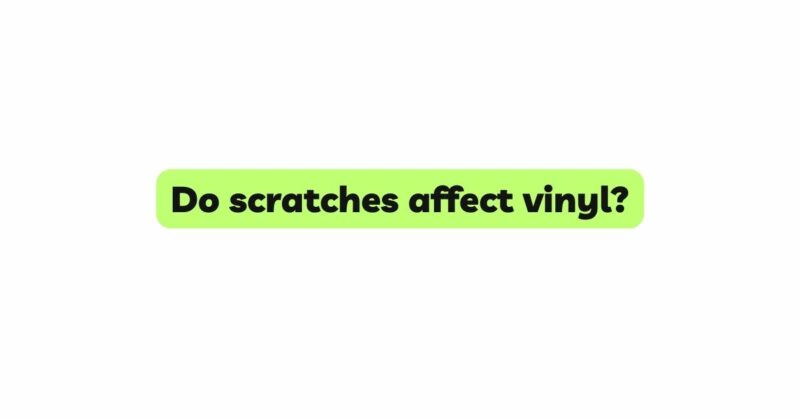Vinyl records have witnessed a resurgence in popularity among audiophiles and music enthusiasts, thanks to their warm, authentic sound and nostalgic appeal. However, the delicate nature of vinyl makes it susceptible to scratches, leading to concerns about the impact of scratches on vinyl records. Do scratches affect vinyl? This article aims to explore the various types of scratches, their consequences on sound quality, the risk of further damage, and the potential for restoration. By understanding the nuances of vinyl scratches, collectors and enthusiasts can make informed decisions about preserving and caring for their cherished vinyl collections.
- The Beauty and Fragility of Vinyl
Vinyl records hold a unique place in the hearts of music lovers, offering a tactile and immersive listening experience. The process of placing the needle on the vinyl and hearing the music come to life is a cherished ritual. However, the delicate nature of vinyl demands careful handling and preservation to maintain the integrity of the music.
- Identifying Types of Scratches
Not all scratches on vinyl records are created equal. Surface scratches, often caused by dust or minor mishandling, are generally shallow and affect the topmost layer of the vinyl. These scratches can cause pops and clicks during playback but usually have minimal impact on sound quality. In contrast, groove-penetrating scratches extend into the grooves where the audio is encoded, and they can cause audio distortion, skips, and repetitive loops.
- The Impact of Scratches on Sound Quality
The impact of scratches on sound quality varies depending on the type and severity of the scratches. Surface scratches may be audible as occasional pops or clicks but typically do not significantly affect the overall sound. On the other hand, deep and extensive groove-penetrating scratches can result in significant audio distortion, detracting from the listening experience.
- The Risk of Further Damage
Playing a vinyl record with scratches carries some inherent risks, particularly when using a worn or misaligned turntable stylus. A damaged stylus can exacerbate scratches, leading to further wear and tear on the grooves. Additionally, repeated playback of a scratched record may cause increased damage over time, making the restoration process more challenging.
- Debunking the Myth of Irreparable Damage
While scratches can affect sound quality and pose risks of further damage, the notion that a single scratch can irreparably ruin a vinyl record is a myth. Many scratched records can be restored through record restoration techniques, such as wet cleaning, mechanical cleaning, and digital restoration. Seeking the expertise of record restoration professionals can often salvage the music and minimize the impact of scratches.
- Safe Handling and Preservation
Proper handling and preservation play a crucial role in preventing scratches and maintaining the quality of vinyl records. Collectors and enthusiasts should handle records by the edges, avoiding touching the playing surface, and store them upright in protective sleeves away from direct sunlight, heat, and moisture.
- Understanding Record Restoration
Record restoration is a delicate art that involves a combination of manual and digital techniques. Depending on the extent of the scratches, various methods, such as wet cleaning to remove dirt and grime, mechanical record cleaning machines for thorough cleaning, and micro-repair kits to address surface scratches, are employed. For deeper groove-penetrating scratches, advanced techniques like high-resolution scanning and 3D imaging aid in precise restoration.
- Digital Alternatives for Preservation
For collectors who are hesitant to play scratched records, digital alternatives can provide access to a vast library of music, including classic vinyl favorites. Digital music platforms and streaming services offer a convenient way to enjoy music without concerns about scratches or wear.
- The Nostalgia of Vinyl Playback
Despite the risks of scratches, the charm of vinyl playback remains unparalleled. The tactile experience of handling vinyl, engaging with album artwork, and the warmth of analog sound make vinyl records a cherished medium for audiophiles. The nostalgic experience of playing vinyl records adds a unique dimension to the listening process.
- Balancing Playback and Preservation
Finding a balance between playing vinyl records and preserving their integrity is essential for collectors. Understanding the impact of scratches, adopting safe playback practices, and seeking restoration when necessary can help strike this delicate balance.
Conclusion
Vinyl records continue to captivate music enthusiasts with their timeless appeal and authentic sound. The question of whether scratches affect vinyl is multifaceted, depending on the type and severity of the scratches, the condition of the turntable and stylus, and the significance of preserving the record.
While scratches can impact sound quality and pose risks of further damage, it is essential to dispel the myth of irreparable damage. Many scratched records can be restored through record restoration techniques, allowing collectors to salvage the music and memories they hold.
Balancing playback and preservation requires understanding the nuances of vinyl scratches and adopting safe handling and preservation practices. By embracing the art of restoration and exploring digital alternatives, collectors can continue to enjoy the charm of vinyl playback while ensuring the longevity and enjoyment of their beloved vinyl collections.
In the end, the decision to play a scratched vinyl record is a personal one, and with proper care and consideration, collectors can continue to cherish the vinyl experience while preserving the beauty and authenticity of their cherished vinyl records for generations to come.

